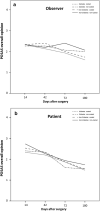Scar quality examination comparing titanium-coated suture material and non-coated suture material on flap donor sites in reconstructive surgery
- PMID: 33143708
- PMCID: PMC7640681
- DOI: 10.1186/s12893-020-00932-3
Scar quality examination comparing titanium-coated suture material and non-coated suture material on flap donor sites in reconstructive surgery
Abstract
Background: Wound healing and scar quality after trauma are subject to impairment through excessive wound healing, chronic wound or even surgical site infections. Optimizing the process of scar formation and skin healing is crucial in virtually all fields of medicine. In this regard, we tested the possible usage and advantages of titanium coated suture material.
Methods: We performed a prospective observational cohort study including 30 patients who underwent soft tissue reconstruction. One half of the donor flap site was sutured with titanium coated suture material, while the other half was closed with non-coated sutures. Scar quality of the donor flap site was assessed by photographs and POSAS scores on days 2-5, 14, 42, 72 and 180 postoperatively.
Results: No difference between the titanium coated sutures and non-coated sutures was seen in the POSAS assessment, neither for the patient scale at 14, 42, 72 and 180 days, nor for the observer scale on the same dates. Comorbidities like diabetes, chronic renal failure and smoking as well as the BMI of each patient affected the wound healing process to an equal degree on both sides of the suture.
Conclusions: No difference between the titanium coated and non-titanium-coated suture material was seen in the POSAS assessment in regard to scar quality and wound healing. The titanium-coated suture material can be considered to be equally as effective and safe in all qualities as the non-titanium-coated suture material, even in patients with comorbidities. Clinical trial register This study is registered at the German Clinical Trials Register (DRKS) under the registration number DRKS00021767. ( https://www.drks.de/drks_web/navigate.do?navigationId=trial.HTML&TRIAL_ID=DRKS00021767 ).
Keywords: POSAS score; Scar quality; Suture; Titanium coated; Wound healing.
Conflict of interest statement
The authors declare that they have no competing interests.
Figures





References
Publication types
MeSH terms
Substances
Associated data
LinkOut - more resources
Full Text Sources
Medical

